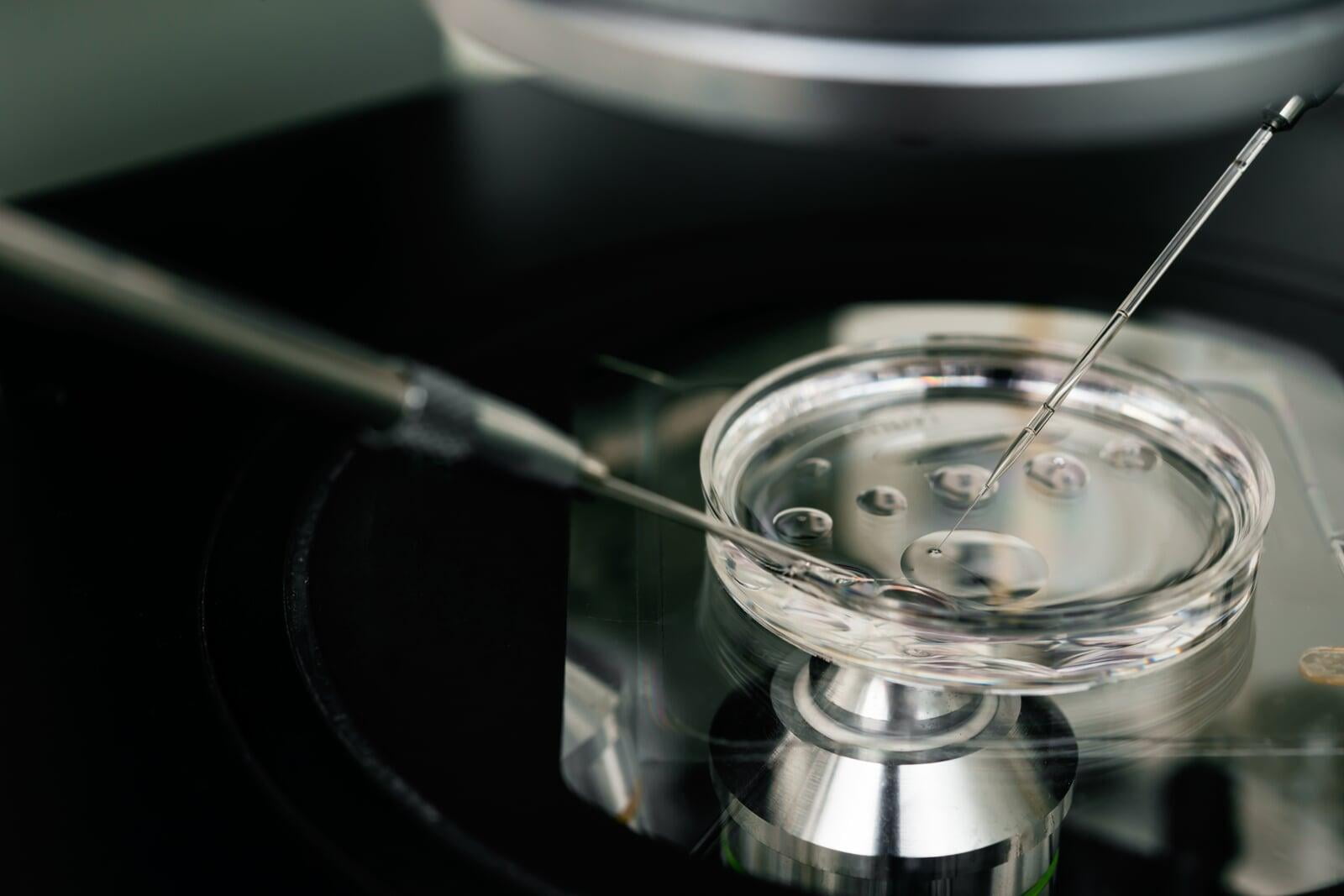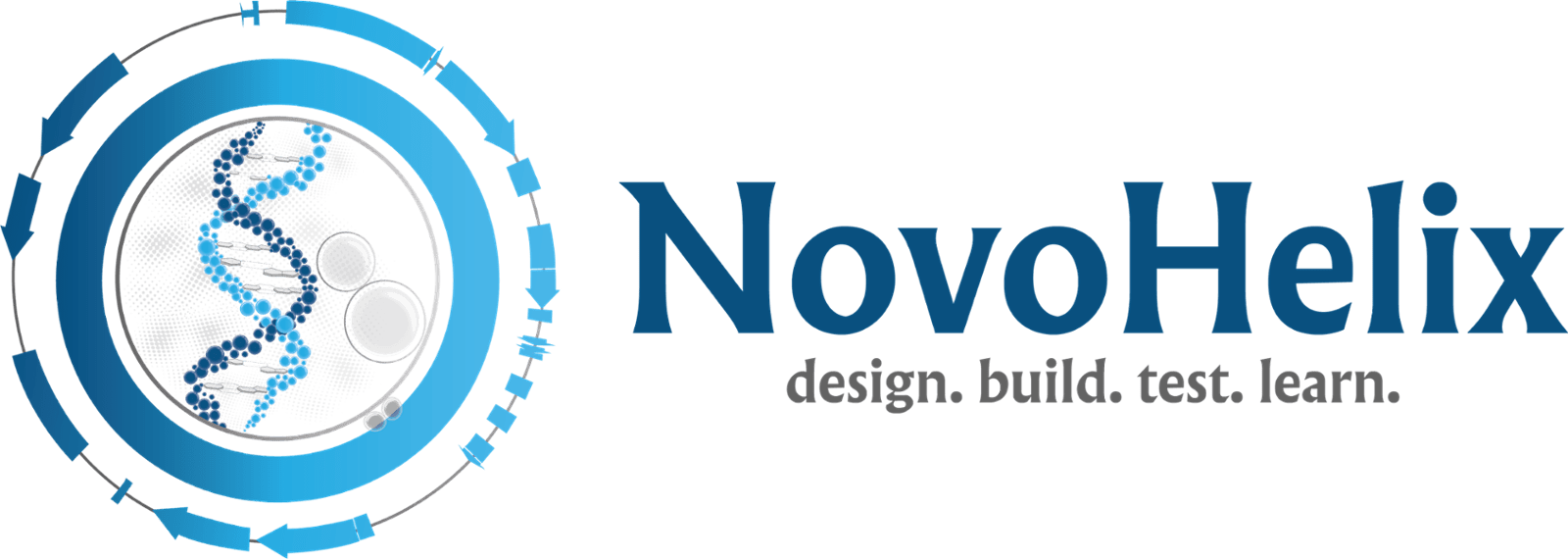
transgenics & microinjection
Service to generate transgenic mice by pronuclear microinjection (random gene insertion).
Transgenic mice are generated by microinjection of the linearized DNA cassette most commonly into the larger male pronucleus of the fertilized mouse zygote¹,²,³,⁴. In contrast to ES-cell gene targeting where the DNA is precisely integrated to a desired genome location by homologous recombination, the microinjected transgene inserts randomly and often contains head-to-tail directional copies known as concatomers⁵,⁶. Integration of the DNA cassette after the first karyokinesis results in a mosaic animal⁷ in which not all of its cells contain the transgene, so typically offspring are screened for the presence of the transgene by PCR genotyping methods. Those animals that test positive known as founder mice (F0) should be mated to determine germline transmission ratios. A detailed description of non-Mendelian germline transmission ratios of mice produced by transgenic construct microinjection is provided by Haruyama et al 2009⁸. While in practice the generation of transgenic mice through microinjection is facile, the highly variable patterns of integration require the use of multiple transgenic lines and experimental validation. Validation methods such as nanopore sequencing to determine the transgene integration site(s)⁹ and copy number of the transgene array is available.
model generation
support services
technology
references
forms
quote request
model generation
Service
Catalog Nr
Service Description
Timeline
Deliverables
Pricing
C57BL/6 Mouse Standard Pronuclear Microinjection
PNMJ001
C57BL/6 strain transgene pronuclear microinjection
~7 - 8 weeks from time of microinjection
2 transgenic founders or 50 liveborn pups (if expression of the transgene would lead to embryonic or perinatal lethality) whichever comes first
C57BL/6 - Premium Pronuclear Microinjection
PNMJ002
Premium service package - C57BL/6 strain transgene pronuclear microinjection
(includes design and construction of transgenic circuit, transgene gel purification, founder genotyping, breeding selected founders to test for germline transmission (F1's) of the transgene, determine approximate transgene array copy number).
~2 - 3 months from time of microinjection
2 transgenic founders or 50 liveborn pups (if expression of the transgene would lead to embryonic or perinatal lethality) whichever comes first
Custom mouse strain - Standard Pronuclear Microinjection
PNMJ003
Custom strain transgene pronuclear microinjection. 129, Balb/c, FVB/N, Balb/c, NOD
Other custom strains available upon request
~7 - 8 weeks from time of microinjection
2 transgenic founders or 50 liveborn pups (if expression of the transgene would lead to embryonic or perinatal lethality) whichever comes first
Custom mouse strain - Premium Pronuclear Microinjection
PNMJ004
Premium service package - FVB/N strain transgene pronuclear microinjection
(includes design and construction of transgenic circuit, transgene gel purification, founder genotyping, breeding selected founders to test for germline transmission (F1's) of the transgene, determine approximate transgene array copy number).
~2 - 3 months from time of microinjection
2 transgenic founders or 50 liveborn pups (if expression of the transgene would lead to embryonic or perinatal lethality) whichever comes first
support services
Service
Catalog Nr
Service Description
Timeline
Deliverables
Pricing
Genotyping Assay Development - Transgenes
PNMJ005
NovoHelix offers a transgene genotyping service to help users develop robust genotyping protocols for screening animals after breeding and expansion of indidvidual transgenic founder lines.
PCR genotyping protocol
Transgene Integration Site Mapping
PNMJ006
Ultra-long read sequencing by nanopores to determine the integration site, approximate transgene copy number and basic structure of the transgene arrayed concatomers. NovoHelix will extract high molecular weight genomic DNA, prepare the nanopore library with adaptors, and load onto the flow cell for nanopore sequencing. A bioinformatic summary of the transgene integration site, structure of the arrayed concatomers and approximate copy number is provided to the client for review. Assessement of the integrity of neighboring genes harboring the transgenic array is also provided. Additional coverage is ultra-long read coverage
7-10 business days
A bioinformatic summary of the transgene integration site, structure of the arrayed concatomers and approximate copy number. Assessement of the integrity of neighboring genes harboring the transgenic array is also provided. 1.5-2x whole genome coverage from ultra-long reads of the assayed transgenic line
Transgene vector construction
PNMJ007
Transgene vector construction and Sanger &/or Minion-sequence verified.
NovoHelix will provide an in silico map and provide restriction fingerprinting for plasmid structure via 3 digests. DNA is purified by a propriety AEX (anion exchange) chromotography and suitable for microinjection into mouse zygotes or nucleofection/electroporation. The DNA is dialyzed on a membrane support in microinjection or electroporation buffer and then spun to remove particulate matter to obviate microinjection needle clogging.
1 - 4 weeks depending on transgene vector complexity
5-10 micrograms of transgene plasmid; sequence validation, in silico map and 3 digests for restriction fingerprinting overall structure.
Transgene purification
PNMJ008
Purification of supercoiled plasmid by a proprietary anion exchange (AEX) chromatography, validation by restriction digestion and analysis by gel electrophoresis. Endotoxin levels are generally very low (0.05 – 0.5 ng LPS/µg) via our proprietary extraction method and are adequate for sensitive applications such as zygotic microinjection of mammalian embryos. The plasmid is predominantly in its supercoiled topology and free of RNA and protein contamination. Linearization with a restriction endonuclease or with a homing nuclease such as PI-SceI, removal of vector backbone by gel extraction and drop dialysis in nucleofection/electroporation/microinjection buffer is included in the purification service. Validation by additional restriction digestions (greater than 3) is available with commensurate fee schedule. Purification is compulsory to prevent the microinjection glass needle from clogging, to prevent embryo lysis and extensive delays in refitting and resetting the microinjection setup.
transgene dsDNA donor vector construction - complex
PNMJ009
Isogenic knockin dsDNA donor vector construction and Sanger-sequence verified with up to 20-kb insertion. For transgenes larger than 20-kb, please see our BAC transgenics services. NovoHelix will provide an in silico map and provide restriction fingerprinting for plasmid structure via 3 digests. DNA is purified by a propriety AEX (anion exchange) chromotography and suitable for microinjection into mouse zygotes or nucleofection/electroporation. The DNA is dialyzed on a membrane support in microinjection or electroporation buffer and then spun to remove particulate matter to obviate microinjection needle clogging.
Mouse colony husbandry & management
PNMJ010
mouse colony management including breeding, weaning, sampling, monitoring, per cage per day for the production of founders and F-generation pups
technology
references
2: Gordon JW, Ruddle FH. Integration and stable germ line transmission of genes injected into mouse pronuclei. Science. 1981 Dec 11;214(4526):1244-6. PubMed PMID: 6272397.
3: Jaenisch R. Transgenic animals. Science. 1988 Jun 10;240(4858):1468-74. Review. PubMed PMID: 3287623.
4: Sato M, Ohtsuka M, Watanabe S, Gurumurthy CB. Nucleic acids delivery methods for genome editing in zygotes and embryos: the old, the new, and the old-new. Biol Direct. 2016 Mar 31;11(1):16. doi: 10.1186/s13062-016-0115-8. Review. PubMed PMID: 27037013; PubMed Central PMCID: PMC4815204.
5: Bishop JO, Smith P. Mechanism of chromosomal integration of microinjected DNA. Mol Biol Med. 1989 Aug;6(4):283-98. Review. PubMed PMID: 2695741.
6: Pawlik KM, Sun CW, Higgins NP, Townes TM. End joining of genomic DNA and transgene DNA in fertilized mouse eggs. Gene. 1995 Nov 20;165(2):173-81. PubMed PMID: 8522172.
7: Palmiter RD, Wilkie TM, Chen HY, Brinster RL. Transmission distortion and mosaicism in an unusual transgenic mouse pedigree. Cell. 1984 Apr;36(4):869-77. PubMed PMID: 6323025.
8: Haruyama N, Cho A, Kulkarni AB. Overview: engineering transgenic constructs and mice. Curr Protoc Cell Biol. 2009 Mar;Chapter 19:Unit 19.10. doi: 10.1002/0471143030.cb1910s42. Review. PubMed PMID: 19283728; PubMed Central PMCID: PMC2743315.
9: Nicholls PK, Bellott DW, Cho TJ, Pyntikova T, Page DC. Locating and Characterizing a Transgene Integration Site by Nanopore Sequencing. G3 (Bethesda). 2019 May 7;9(5):1481-1486. doi: 10.1534/g3.119.300582. PubMed PMID: 30837263; PubMed Central PMCID: PMC6505145.
forms
quote request
